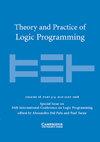命题答案集程序的聚合语义
IF 1.1
2区 数学
Q3 COMPUTER SCIENCE, SOFTWARE ENGINEERING
引用次数: 5
摘要
答案集编程(ASP)作为知识表示和推理的范式出现于20世纪90年代末。ASP的吸引力建立在具有表现力的高级建模语言以及强大的现成解决系统的可用性之上。虽然在建模语言中整合聚合表达式的实用程序几乎与第一个ASP求解系统同时实现,但聚合的一般语义及其有效实现一直是长期存在的挑战。在数据库系统中,以及演绎数据库语言Datalog中,已经提出并广泛使用了aggregation, Datalog是ASP的主要先驱之一。然而,在Datalog中,聚合的使用仍然受到限制(要么不允许递归,要么只允许单调聚合),而在ASP环境中,有几种方法可以集成不受限制的聚合。在这项调查中,我们通过展示和比较已经为命题ASP程序提出的主要聚合语义,从这一点开始。我们强调了计算复杂性和表达能力等关键属性,并通过说明性示例概述了不同方法的功能和局限性。本文章由计算机程序翻译,如有差异,请以英文原文为准。
Aggregate Semantics for Propositional Answer Set Programs
Answer set programming (ASP) emerged in the late 1990s as a paradigm for knowledge representation and reasoning. The attractiveness of ASP builds on an expressive high-level modeling language along with the availability of powerful off-the-shelf solving systems. While the utility of incorporating aggregate expressions in the modeling language has been realized almost simultaneously with the inception of the first ASP solving systems, a general semantics of aggregates and its efficient implementation have been long-standing challenges. Aggregates have been proposed and widely used in database systems, and also in the deductive database language Datalog, which is one of the main precursors of ASP. The use of aggregates was, however, still restricted in Datalog (by either disallowing recursion or only allowing monotone aggregates), while several ways to integrate unrestricted aggregates evolved in the context of ASP. In this survey, we pick up at this point of development by presenting and comparing the main aggregate semantics that have been proposed for propositional ASP programs. We highlight crucial properties such as computational complexity and expressive power, and outline the capabilities and limitations of different approaches by illustrative examples.
求助全文
通过发布文献求助,成功后即可免费获取论文全文。
去求助
来源期刊

Theory and Practice of Logic Programming
工程技术-计算机:理论方法
CiteScore
4.50
自引率
21.40%
发文量
40
审稿时长
>12 weeks
期刊介绍:
Theory and Practice of Logic Programming emphasises both the theory and practice of logic programming. Logic programming applies to all areas of artificial intelligence and computer science and is fundamental to them. Among the topics covered are AI applications that use logic programming, logic programming methodologies, specification, analysis and verification of systems, inductive logic programming, multi-relational data mining, natural language processing, knowledge representation, non-monotonic reasoning, semantic web reasoning, databases, implementations and architectures and constraint logic programming.
 求助内容:
求助内容: 应助结果提醒方式:
应助结果提醒方式:


